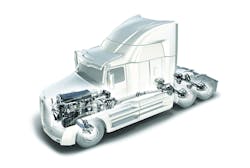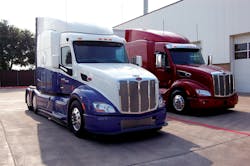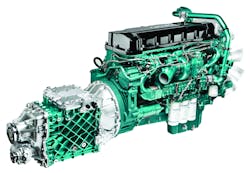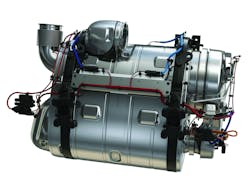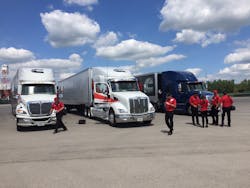The trucking industry is experiencing three phases of powertrain development being driven in part by the Phase 2 greenhouse gas (GHG) regulations, which mandate fuel economy improvements for commercial trucks. That’s what Mike Roeth, executive director of the North American Council for Freight Efficiency, will tell you.
“We’re already through the ‘smart’ phase, where the engine, transmission, and even the axles now include built-in intelligence of a sort,” he explains. “Axles themselves are not ‘smart’ in the sense that like an engine or transmission they feature computer controls. But they come in new configurations such as the 6x2 design and new ratios that give them a flexibility they haven’t had before.”
Roeth says the industry is currently in the middle of what he calls the “integration” phase of the truck powertrain development track.
“We’re working toward optimization of all three components—engine, transmission, and axles—and are now adding over-the-air update capability for engines and possibly transmissions at a later point,” he points out.
That’s going to allow powertrains to morph into different specifications to provide optimized capabilities for obtaining the best fuel economy and performance operating in flatlands or mountains, for example, all without having to change out powertrain hardware to gain those benefits.
Prognostication
Now, the industry is entering into the third phase of this powertrain evolution process by adding what Roeth dubs “topographical adjustment” capability to the powertrain.
“We’re letting the powertrain—the engine and transmission, even the axles to a degree—determine the best rpm, gearing, etc., based on the topography details it is being fed,” he says.
“The key is that we are now sharing more proprietary information over a wider course of [truck] duty cycles. We’re also expanding that integration down the drivetrain.”
- Alex Stucky, Eaton Corp
At Navistar, route details are already being programmed into the powertrain on the front end to allow it to improve fuel economy, says Jim Nachtman, on-highway marketing manager. “I think, for us, we are as far as we can go in terms of programming in road terrain for predetermined routes,” he explains. “Going forward on that level, it’s about improving the algorithm controlling the engine and engine braking to fine-tune fuel savings.”
Nachtman says adjusting the shift schedule of the transmission itself with real-time data, literally integrating it with telematics, is next.
“That is the next opportunity,” he explains. “There’s work being done here, but it’s where the biggest opportunity for integration remains.”
Alex Stucky, global strategy manager for commercial vehicle transmissions at Eaton Corp., adds that truck makers and suppliers are tapping more deeply into real-time and real-world data on the engineering front so they can improve and better integrate component design.
“The key is that we are now sharing more proprietary information over a wider course of [truck] duty cycles,” he explains. “We’re also expanding that integration down the drivetrain by sharing more information with axle manufacturers, for example, to gain more visibility across all the powertrain components and how to make them work together better as a single system.”
Cummins Engine highlighted the importance of powertrain integration as part of the rollout of its 2017-compliant “X Series” engines. The heavy-duty X15 Performance Series and the X15 Efficiency Series went into production at the end of 2016; the X12 medium-duty engine starts production this year.
The X15 Efficiency Series is tuned to provide maximum fuel economy, the company says, noting that it delivers 3% better fuel economy versus 2016 equivalent models and an improvement of over 10% versus 2010 equivalent displacements. The X15 Efficiency Series is rated at 400 to 500 hp. and delivers 1,450 to 1,850 lbs.-ft. of torque.
By contrast, the X15 Performance Series is focused on providing more power, especially for heavy loads. It’s rated between 485 and 605 hp. and delivers 1,650 to 2,050 lbs.-ft. of torque.
Finally, the X12 medium displacement engine from Cummins weighs in at just 2,050 lbs., cranks out 350 to 475 hp., and delivers 1,250 to 1,700 lbs.-ft. of torque.
All three engines are integrated with the Cummins EcoFit Single Module aftertreatment system, which is up to 60% smaller and 40% lighter than the previous two-stage units.
Added benefits can be gained via the SmartAdvantage integrated powertrain Cummins offers with Eaton to allow major fuel savings now and in the future, explains Srikanth Padmanabhan, president of Cummins’ engine division. “By precisely adjusting to grade, vehicle weight and throttle position, together with features such as ADEPT, SmartCoast and predictive cruise control, we can make every driver an expert,” he says.
Eaton’s Stucky adds that the SmartAdvantage powertrain is also being offered as a multi-torque model compatible with Cummins SmartTorque2 functionality. It is available in both ISX15 SA and X15 SA engines rated up to 500 hp. and 1,550 to 1,850 lbs.-ft. of torque and will not require the use of a transmission cooler.
“The 1,850 lbs.-ft. rating has been added to provide customers with improved grade capabilities and acceleration,” he explains, boosting truck performance in tough spots such as highway on-ramp entrances.
And Stucky stresses there still remains lots of room for making improvements in terms of fuel savings and performance. “We keep building on our relationships, and we keep finding little nuggets of savings,” he emphasizes. “Take SmartCoast or neutral coast. For a while, that was difficult to accept—shifting a tractor-trailer going down the road at highway speeds into neutral—but now we do.”
Stucky adds that there are probably other features like that out there that haven’t been discovered yet. “Those will develop from further integration opportunities over the next couple of years, especially in terms of meeting GHG targets,” he says.
Sean Waters, director of compliance and regulatory affairs for Daimler Trucks North America, says that’s one of the good things about the Phase 2 GHG rules. According to Waters, the key parts that make the Phase 2 GHG rules “good rules” from the OEM’s perspective are its long lead times—with compliance deadlines of 2021, 2024, and 2027—along with flexibility in terms of deploying solutions to meet the rules’ fuel economy targets.
“There are lots of different things we can do; we’re allowed to mix and match features,” he explains. “We are also not forcing customers to buy specific technologies. That’s why we don’t think there will be any ‘cliff events’ or prebuys due to the rules.”
Mapping it out
Having that road map established for the long term—in the case of the Phase 2 GHG rules, for the next decade—is beneficial, though that doesn’t mean complying with the rules from a powertrain standpoint is easy by any means. That’s in no small part because the Phase 2 GHG rules themselves number over 1,600 pages in length; there are between 4,000 and 5,000 pages worth of supporting documents.
“It will be a challenge. These are tough standards that will cost a lot of money for R&D, but they are achievable,” Waters notes.
The federal government is helping underwrite some of that research and development cost via the funding of SuperTruck projects through the Dept. of Energy (DOE). Those projects—cost-shared public-private partnerships that involve OEMs such as Volvo Trucks North America (VTNA) among many others—are helping to step up improvements in powertrain hardware as well, specifically engine design.
“SuperTruck resources were used to develop our new common rail fuel system, wave piston, and turbo compounding system, all part of our 2017 powertrain lineup,” notes John Moore, VTNA’s marketing product manager for powertrains.
“The resources provided by the DOE allowed us to gain greater efficiency, along with a deep reduction in cylinder soot output, and also taught us how important the entire vehicle is in gaining higher fuel efficiency,” he adds. Moore notes that the project combined tractor and trailer aerodynamics with low rolling resistance tires, lightweight carbon fiber vehicle components, and increases to the “brake thermal efficiency” of the engine by using waste heat recovery technologies.
Those efforts, in tandem with the GHG regulations and “competitive market forces,” will drive further intensive integration efforts among truck OEMs over the next few years, he notes.
“Smarter integration between the engine, transmission and axles, which in turn improve fuel efficiency, is demanded by our customers and required by impending GHG rules,” he continues. “On the horizon, rear axle ratios below 2.2 in combination with overdrive will drive fuel efficiency even higher for highway applications.”
Such “smarter integration” also includes broader links between the powertrain and GPS to anticipate powertrain loads created by topography.
“I-See, Volvo’s predictive cruise released this year, does just that,” Moore notes. “On the radar is ‘smart programming’ to help engine torque better match load conditions in demanding mountainous conditions, with parameters then switched back once you return to a level road. Such ‘telematics gateways’ will also help drivers find better routes with less congestion in real time.”
A big positive
The final Phase 2 GHG rule package is straightforward and positive, says DTNA’s Waters. “Ultimately, we decided we really like this rule,” he explains, primarily because the flexibility built into the rules will help motivate the development of technology for real-world fuel economy gains.
“That’s a big positive. There will be better total cost of operation for customers in the long run. We’re confident we can do that,” Waters says.
Most OEMs remain mum on what it will cost to comply with the Phase 2 rules and how much will be added to the base sticker price of a Class 8 truck. The Environmental Protection Agency projects a two-year payback window for linehaul operations because of fuel savings from these technological improvements, and Waters believes that projection is fairly accurate.
“We think that’s a reasonable payback period,” he says. “We think we’ll be delivering a value package that will reduce total cost of operation for the customer.”
Integration in the real world
Back in 2013, paccar followed an integration path blazed by Cummins Engine Co. and Eaton Corp. by developing an integrated powertrain package called APEX that paired a Paccar MX-13 engine with Eaton AMT transmission units. This initial combination featured optimized shift calibration, weight savings, and proprietary control logic that resulted in an improvement in fuel efficiency of up to 4%.
Flash forward four years and now Paccar is rolling out enhancements to its MX-13 and MX-11 engines that include a new single-cylinder air compressor, variable displacement oil pump, and variable speed coolant pump. The OEM also extended the oil and fuel filter change intervals from 60,000 mi. to 75,000 mi. for those engines, and it introduced a single-canister aftertreatment system much like Volvo’s EATS (exhaust aftertreatment system), which reduces weight by 100 lbs.
How does any of that help fleets, especially those that don’t operate for extended lengths of time at steady-state highway speeds?
The answer can be found with Reliable Trucking, a construction fleet that hauls dirt, aggregate, cement, and fly ash, among other material, in the San Francisco Bay Area and in the Sacramento Valley.
Reliable recently started spec’ing lightweight Kenworth T880 tractors equipped with MX-11 engines integrated with Eaton Fuller UltraShift Plus AMT. By switching to an 11L versus 13L engine, the fleet sliced 400 lbs. from its overall truck weight, with another 100 lbs. tacked on from other spec’ing changes. By using an integrated powertrain built around the MX-11, which generates 430 hp. with 1,550 lbs.-ft. of torque, Reliable didn’t sacrifice on performance yet saved on fuel.
“We’re getting the same pulling power as we were with our previous engine but with better fuel economy. That can mean up to $1,000 a year in fuel savings per truck,” Joe Sostaric, Reliable’s general manager, says. “Those are big numbers with a big payback. And when you can increase your payload by 2%, you’re talking substantial dollars. This is a very competitive business.”
Gary Wagner, one of Reliable’s drivers, has been operating trucks for nearly 30 years. He notes that switching from a manual to an AMT connected to a smaller engine in Reliable’s trucks didn’t rob him of performance.
“I’m never left begging for power with the MX-11 combination,” he says. “I can’t tell the difference between this and the bigger MX-13 engine we were driving before.”
About the Author
Sean Kilcarr
Editor in Chief
Sean Kilcarr is a former longtime FleetOwner senior editor who wrote for the publication from 2000 to 2018. He served as editor-in-chief from 2017 to 2018.
